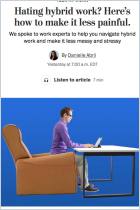Join getAbstract to access the summary!

Join getAbstract to access the summary!
Danielle Abril and Drew Harwell
Keystroke tracking, screenshots, and facial recognition:
The Boss May Be Watching Long After the Pandemic Ends
The Washington Post, 2021
What's inside?
Forget Big Brother — now Big Boss is watching employees’ every move at home.
Recommendation
When COVID sent workers home, many employers felt a need to track their remote workers’ productivity and commitment. The use of electronic monitoring platforms like Hubstaff and Teramind grew popular, and they’re likely here to stay. Washington Post reporters Danielle Abril and Drew Harwell report how this surveillance makes workers feel mistrusted, and they explore how firms either respect or breach their staff’s expectation of privacy. The authors warn employees to learn their employers’ policies, because – depending on your jurisdiction – legal protections may be scanty.
Summary
About the Authors
Danielle Abril reports on how technology affects workers and the workplace for The Washington Post, where Drew Harwell covers artificial intelligence (AI) and how algorithms affect people’s lives.



















Comment on this summary